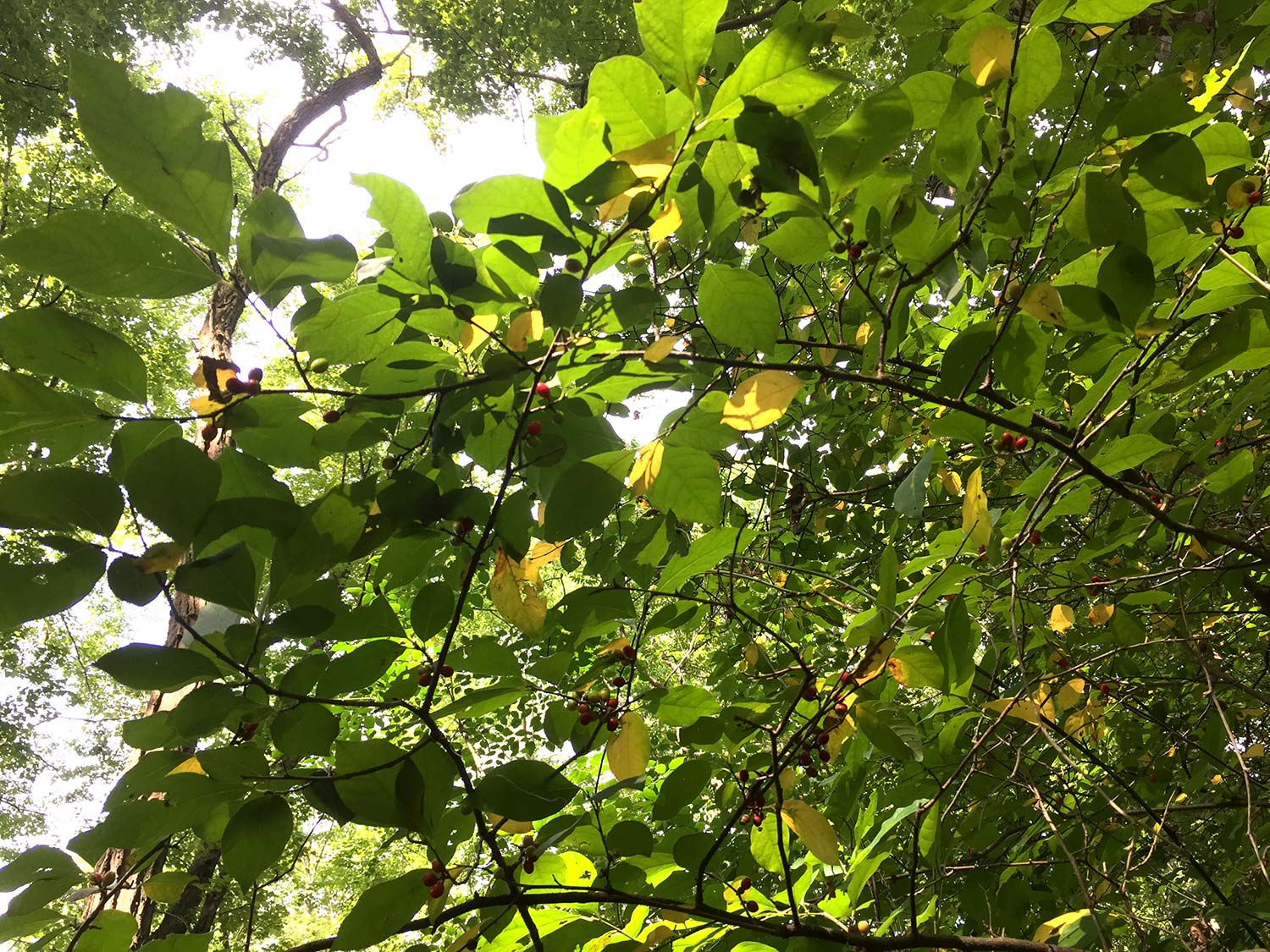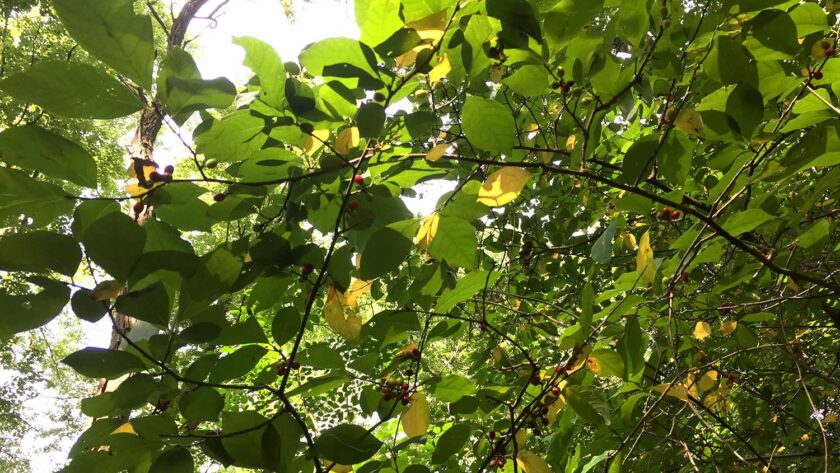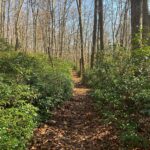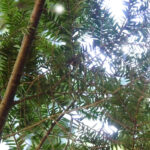
As I continue to explore some of the most important understory trees in the US East Coast and Midwest region, we turn our attention today to the amazing Spicebush (Lindera Benzoin). Historically, Spicebush was an incredibly important plant, medicine, and spice both to Native Americans and early white settlers in the US and yet today has largely been forgotten in history. Spicebush is a native understory tree with a large range in North America, spanning from Maine to Florida and all the way across the south and Midwest to Texas and up to Ontario. While I’ve taught this plant routinely on my plant walks, and what amazes me is that nobody can even identify it, much less recognize how it might be used. Spicebush has an incredible flavor, medicinal value, and offers much in the way of magic and mystery. It certainly deserves a place in our consciousness and in our traditions.
This post is part of my Sacred Trees in the Americas series. In this series, I explore the magic, mythology, herbal, cultural, and divination uses, with the goal of eventually producing a larger work that explores many of our unique trees located on the US East Coast (which I hope to have completed by early 2022). For my methods, you can see this post. Other trees in this series include Rhododendron, Witch Hazel, Staghorn Sumac, Chestnut, Cherry, Juniper, Birch, Elder, Walnut, Eastern White Cedar, Hemlock, Sugar Maple, Hawthorn, Hickory, Beech, Ash, White Pine, Black Locust, and Oak. For information on how to work with trees spiritually, you can see my Druid Tree Working series including finding the face of the tree, communicating on the outer planes, communicating on the inner planes, establishing deep connections with trees, working with urban trees, tree energy, seasonal workings, and helping tree spirits pass.
Ecology
Widely distributed across North America, Spicebush is an understory tree that prefers damp soil and can grow in full shade, part shade, or full sun. Spicebush can grow up to 6-12 feet tall. Spicebush reproduces by colonizing, thus, when you find it, it often grows in large patches in the forest understory. Here in the Appalachian mountains, you will find it growing in deciduous forests on damp hillsides, in wet areas where there are ephemeral springs, or along river bottoms. When you see spicebush, it is often indicative of rich and fertile soil; it also prefers to grow in areas rich in limestone. Here on the Druid’s Garden Homestead land, we have it throughout our property as an understory tree with Oak-Hickory-Sugar Maple-Black cherry overstory.

One of the key features of Spicebush is that it has an extremely early bloom time with fragrant flowers reminiscent of lemon. The clustered bright yellow blooms appear earlier than almost any other tree in our ecosystem. In Western Pennsylvania, it is typically blooming in early March, which is about the same time you start to see the Skunk Cabbage and Crocuses pop up and usually when the maple sap is running! You can often see this blooming sometimes while the snow is still on the ground (making it a very interesting counterpart to Witch Hazel who blooms in very late fall, from a bloom perspective). In the case of Spicebush, it blooms early so it can set its fruit early, well before the overstory trees bloom out and shade out the Spicebush. This is so characteristic of many of the other understory trees and bushes–all of them adapt themselves to be at peak in colder or darker times when light reaches the forest floor.
Spicebush is an important food source for wildlife. Larger mammals like whitetail deer, opossum, and eastern cottontail rabbit feed on the leaves, twigs, and berries. Many species of birds, both game birds, and songbirds, also feed on the berries, particularly in the winter months. Spicebush is host to two butterflies–the spicebush swallowtail (Papilio Troilus) and the Promethea silkmoth (Callosamia Promethea). The spicebush swallowtail lays eggs on Spicebush and then the larvae curls up the leaves to create a cocoon.
Foraging and Cooking with Spicebush
Spicebush is also known as Wild Allspice, Appalacian Allspice, Spicewood, Feverbush, Snap-bush, Snapwood, and Benjamin-Bush. Many of these names are tied to the fragrant and amazing spice this bush produces for culinary arts. In fact, Spicebush has been seeing something of a renaissance within the foraging community in the last decade or so. Even so, its more widespread use as a spice and food has not so far seemed to permeate beyond wild food foraging at present and into regional cuisine, which is honestly a shame. In fact, Marie Viljoen who wrote the 2018 book Forage, Harvest, Feast makes the bold statement that if Spicebush were better known, it could form a cornerstone of regional Appalachian cuisine, demonstrating the power of this plant for cooking and culinary use.
Spicebush twigs and leaves can be made into a fragrant, slightly spicy tea that is reminiscent of a chai. The tea is slightly spicy, slightly sweet, and quite pleasant to drink. This is actually one of my favorite wild teas when I’m camping or foraging–just pick a few leaves and brew them up. There are places I camp every year that are rich in spicebush and I always look forward to this warming tea on a gentle summer night.
The second way you can make tea when there are not leaves is by harvesting fresh twigs. To make a tea from the twigs, just brew them up with a lid on for 20-30 min (using low heat or even a crockpot to preserve the flavor). The tea is similar to leaf tea: spicy, warming, and slightly sweet.
The real magic of the Spicebush from a culinary and wild food perspective is in the spicebush berry. The green berry (unripe) and red berry (ripe) offer two different culinary experiences. The green berries are very sharp, lemony, and peppery and can be harvested anytime before they go red. The green berries are most intense when they are smaller and less plump. They can be used as a pepper substitute due to their very strong taste.
The berries go red in the early fall (you can see this from my images; the leaves start to yellow just as the berries go red). As they go red, you can begin to harvest them. They will actually stay on the bush for 2 months or more, so you have a very long window for harvest. A good spicebush harvest can offer you several years of spice, which is pretty incredible.
I have found that the easiest way to preserve either red or green berries is to dehydrate them and then place them in the freezer. This prolongs their shelf life and intensifies the flavor. It is important to note that fresh spicebush berries can have a very numbing sensation on the tongue. By drying the berries, all the good spice is left with none of the numbing presents in the fresh berries. Once dry, you will taste that wonderful spice, very much its own flavor but with hints of allspice, nutmeg, cinnamon, grains of paradise, citrus, and pepper, but you will also have your tongue go numb. You can also use them fresh in curries and the like; cooking also can remove the numbness.
Marie Viljoen offers over 50 recipes in her Forage, Harvest, Feast that uses spicebush including combining it with citrus for refreshing drinks, using it as a seasoning in many diverse dishes, and using it as a dry rub on meats. Here are a few recipes online to get you started: foraged spicebush macaroons, acorn baklava with spicebush berry, a foraged dry rub (I’ve made a version of this and it is divine), a wild curry mix, and making a spicebush ice cream!
Traditionally, as Danie Moerman describes in Native American Food Plants, Native American uses of Spicebush were similar to what I have described above: spicebush was used by the Cherokee and Chippewa to make a beverage, including the stems to make tea. The spice berries themselves were used to flavor opossum or groundhog. The Chippewa specifically used the berries to help mask or change meats with a strong or gamey flavor (p. 141).
Spicebush in Herbalism
Spicebush is infrequently Traditional Western Herbalism today, but historically, it was frequently used to treat a range of conditions. One of its names, fever bush, offers key insight into the nature of this plant. King’s American Dispensatory and Cook’s Physiomedical Dispensary describes Spicebush bark and berries being used for medicine here in the Americas. Spicebush is an aromatic herb being used primarily to treat fever (hence its name fever bush). A decoction (strong tea) was one of the treatments used as a diaphoretic (to support a healthy fever response and regulate body temperature). It was used to treat all fevers including auge, typhoid, and rheumatic fevers. The berries were used primarily as a stimulant being used for a range of applications including supporting a healthy digestive system (carminative) particularly for alleviating excess gas. The berries can be distilled to create an essential oil of spicebush that is particularly useful for topical applications like bruises and rheumatism.
Spicebush in Magic, and Myth
Spicebush in the Magical and Occult Traditions. Like many of my other understory plants, powerful yet unnoticed and unremarked upon, Spicebush has no mention that I can find in this lore. This includes within the Hoodoo tradition and within the broader Western Occult traditions. However, the Latin name offers us some insight. The reason that the Latin name of Spicebush is Lindera Benzoin is that the oil found in all parts of the plant (part of what makes it tasty, see below) contain benzoic acid, which is the same chemical compound as Styrax Benzoin (for anyone who has used Benzoin incense). Burning the leaves, stems, or berries can give you a benzoin-like aroma, making it a great local incense source (for more on creating incenses generally, see this post on the general practice and this one on local tree incenses). I believe this plant has the potential for a local replacement for anyone who is using Benzoin or other incenses.

Native American Traditions. Beyond food uses, I was unable to find anything about mythology, herbal, or other uses by Native Americans for spicebush. While Native Americans also used this plant for medicine and food, (see the Ethnobotany of the Indiana Dunes National Lakeshore) the specific uses are not specified. One note in this entry is that Spicebush growing is a sign of a healthy and rich forest.
Spicebush: Magical and Divination Uses
Based on all of my research as well as my own experiences, I want to share three possible divination and magical uses for spicebush.
Masking or illusion. Spicebush’s strong aromatic quality has been used in culinary traditions for a variety of enhancements, alterations, and masking of strong flavors. As suggested by the doctrine of signatures, this kind of quality can not only apply to the use of this tree as a culinary herb but also, as a magical one.
Enhancement. Spicebush’s strong aromatic quality also lends itself well to any workings where something needs to be elevated or enhanced in some way. The spice of the berries literally take ordinary foods and turn them into something unique and extraordinary–and the same can be said of other ways in which you might bring this unique and wonderful tree into your life.
Acting Swiftly and being Early. Another meaning of the Spicebush is the power in doing things early, swiftly, and ahead of time. The Spicebush takes advantage of the late winter sun when the overstory is still bare to set fruit and prepare for the season. Thus, she offers us a powerful lesson with regards to action and focusing on being prepared in advance.




Reblogged this on Blue Dragon Journal.
Reblogged this on Paths I Walk.
[image: IMG_20210312_142219.jpg]
Wonderful, as always! In Bat Cave, they are just starting to bloom!
Sara
On Sun, Mar 14, 2021 at 9:32 AM The Druid’s Garden wrote:
> Dana posted: ” As I continue to explore some of the most important > understory trees in the US East Coast and Midwest region, we turn our > attention today to the amazing Spicebush (Lindera Benzoin). Historically, > Spicebush was an incredibly important plant, medicine,” >
Awesome! :).
Ich bereue es nicht, dass ich mir die Zeit genommen habe, so einen guten Artikel zu lesen.
Thank you, Lokonida! I don’t speak much German, but I appreciate your comment :).
I love your Posts, Dana. I read them every week. I am grateful for your wisdom and appreciative of your sharing. I live in Maine and we have a woman here who is also quite special. Her name is Deb Soule ( Avena Botanicals) . I am signed up for a course she is offering through BotanicWise.com . There is a cost involved but I thought I would pass it along to others who love plants! Thank You again for all that you do, Dana. Can’t wait to read your book when it comes out! Robbie
https://www.botanicwise.com/healing-garden-deb-soule
“For there is always light, if only we’re brave enough to see it If only we’re brave enough to be it.” Amanda Gorman
>
Hi Robbie–it is always a good idea to study with a local, wise herbalist. I feel like my spiritual practices deepened considerably when I was able to take some years to study with a local folk herbalist. I wish you blessings on this new journey! 🙂
Thank you for this wonderful article! Really enjoyed it!
Thank you, Heather! Nice to hear from you :).
I loo ok be learning and experiencing through what you share. I listened to this from Robin Wall Kimmerer on pecans and thought you might enjoy. (Take or leave as desired of course!)
https://arboretum.harvard.edu/events/directors-lecture-series/
brooke
>
Yes, I’ve read her work and have heard her speak. She’s wonderful! 🙂
Dana,
Greetings! I wish you and yours many lovely Spring Equinox blessings.
I have sad news to share and would love to hear your input. A giant sequoia tree was drilled and poisoned in nearby Portland. Audubon Society has offered $1000 to find the criminal(s). They’re not sure the tree will survive.
Is there something I can do? My first thought was to find where it’s at and place offerings at its base. I have sent requests to my neighboring trees to collectively speak with and send healing energy to this grand sequoia. Is there perhaps any flower essence remedies or other “druidic” healing approaches to this matter? Thank you kindly. 💚
https://katu.com/news/local/reward-offered-after-giant-sequoia-poisoned-in-ne-portland
XMA Header Image
Hi Regina,
Thanks for reaching out. There’s a lot you can do for this tree. I would start with intense ritual work–the idea here is to raise as much energy as you can for healing. If you can find it, great. But if not, even distance work can be effective if you focus on the tree. In terms of energy raising, different traditions do it in different ways–there’s energetic raising of energy using visualization (so in AODA, we would focus on raising the telluric currents of energy from the earth and bringing down the solar currents of energy from the sun and bringing that into the tree). Or you can do more ecstatic forms of energy raising like through chanting, drumming, singing, etc. The point is–send as much good energy as you can to that tree, and see how many other people you can get join you. If you are skilled in shamanistic and plant spirit journeying, you can reach out to the tree, speak with the tree spirit, and see what else you can do.
If you can physically get to the tree, energy work is key.
You could also see if you can enlist the help of other local plants–I’m not an expert in the plants out where the Sequoias live, but here, I would use things that directly address poison and assist with flow: I might use a diuretic plant like stinging nettle and an expelling tree like Walnut.
Best of luck and let me know how it goes.
Thank you kindly! 💚🙏🌲✨ I have a dear friend with whom I’ll share your message. We will combine energies and take action on behalf of this great tree.
Hi Dana,
It’s been a busy day and here are the results: two blogs, the making of a healing medicine bag, and a road trip to visit the sequoia tree. Thank you again for your loving guidance!
https://reginachante.org/2021/03/21/prayer-request-for-the-grand-sequoia-tree/
https://reginachante.org/2021/03/21/making-a-medicine-bag/
Awesome! I read both of the posts and they are great. I’m so glad you are reaching out for help with this tree. I will send some energy as well, of course :). Do let me know how it goes and if the tree makes it. Blessings, Dana
Thank you Dana.🌸. I will let you know. At this time they’re waiting to see if the tree will survive.🙏
Your mention of two tribes that flavored wild game with spicebush may be correct but from my direct teaching and experience the boiling of wild game in spicebush was to kill parasites. In my early 20s my ex and I drank spicebush tea and she showed a three foot worm she pulled out of her. I treated myself this last winter when I had horrid continuing diarrhea first with wormwood. Which helped a lot but did not totally alieve the symptoms then I took one stong cup of spicebush tea scraped from some straight shoots and my problems were gone.
Hi Eugene, most spices that are used in food have multiple medicinal virtues also tied to GI issues, so what you are sharing doesn’t surprise me at all! Especially because parasites can be such a bad issue in wild game.
Did you use the tea from the branches? (I’d assume so based on what you said). I also like the leaves in tea. The entire plant is such a wonderful healing and medicinal plant :).